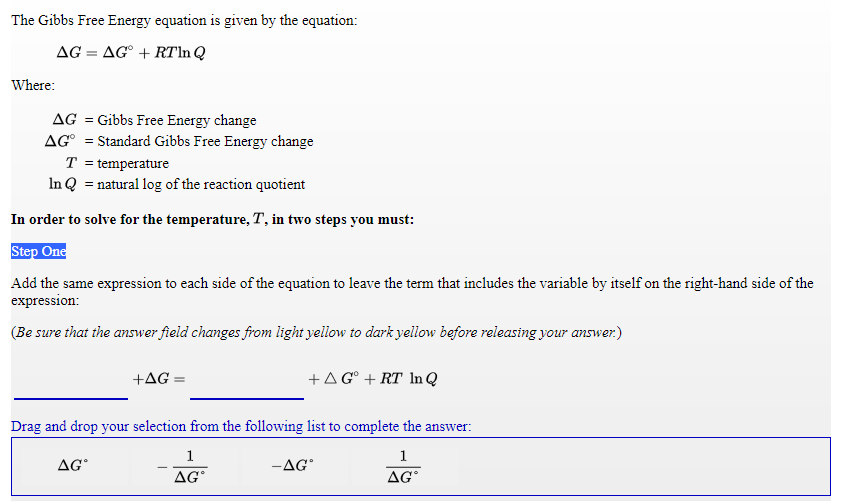The Gibbs Free Energy equation is given by the equation: AG = AG° + RTIN Q Where: AG = Gibbs Free Energy change AG° = Standard Gibbs Free Energy change T = temperature In Q = natural log of the reaction quotient In order to solve for the temperature, T, in two steps you must: Step One Add the same expression to each side of the equation to leave the term that includes the variable by itself on the right-hand side of the expression: (Be sure that the answer field changes from light yellow to dark yellow bęfore releasing your answer.) +AG = +A G° + RT InQ Drag and drop your selection from the following list to complete the ans answer: 1 1 AG° -AG° AG AG
The Gibbs Free Energy equation is given by the equation: AG = AG° + RTIN Q Where: AG = Gibbs Free Energy change AG° = Standard Gibbs Free Energy change T = temperature In Q = natural log of the reaction quotient In order to solve for the temperature, T, in two steps you must: Step One Add the same expression to each side of the equation to leave the term that includes the variable by itself on the right-hand side of the expression: (Be sure that the answer field changes from light yellow to dark yellow bęfore releasing your answer.) +AG = +A G° + RT InQ Drag and drop your selection from the following list to complete the ans answer: 1 1 AG° -AG° AG AG
Chemistry: Principles and Practice
3rd Edition
ISBN:9780534420123
Author:Daniel L. Reger, Scott R. Goode, David W. Ball, Edward Mercer
Publisher:Daniel L. Reger, Scott R. Goode, David W. Ball, Edward Mercer
Chapter17: Chemcial Thermodynamics
Section: Chapter Questions
Problem 17.104QE: What is the sign of the standard Gibbs free-energy change at low temperatures and at high...
Related questions
Question

Transcribed Image Text:The Gibbs Free Energy equation is given by the equation:
AG = AG° + RTln Q
Where:
AG = Gibbs Free Energy change
AG° = Standard Gibbs Free Energy change
T = temperature
In Q = natural log of the reaction quotient
In order to solve for the temperature, T, in two steps you must:
Step One
Add the same expression to each side of the equation to leave the term that includes the variable by itself on the right-hand side of the
expression:
(Be sure that the answer field changes from light yellow to dark yellow before releasing your answer.)
+AG =
+AG° + RT In Q
Drag and drop your selection from the following list to complete the answer:
1
1
AG
-AG
AG°
AG
Expert Solution
This question has been solved!
Explore an expertly crafted, step-by-step solution for a thorough understanding of key concepts.
This is a popular solution!
Trending now
This is a popular solution!
Step by step
Solved in 2 steps with 1 images

Knowledge Booster
Learn more about
Need a deep-dive on the concept behind this application? Look no further. Learn more about this topic, chemistry and related others by exploring similar questions and additional content below.Recommended textbooks for you

Chemistry: Principles and Practice
Chemistry
ISBN:
9780534420123
Author:
Daniel L. Reger, Scott R. Goode, David W. Ball, Edward Mercer
Publisher:
Cengage Learning

Chemistry: The Molecular Science
Chemistry
ISBN:
9781285199047
Author:
John W. Moore, Conrad L. Stanitski
Publisher:
Cengage Learning

Chemistry: An Atoms First Approach
Chemistry
ISBN:
9781305079243
Author:
Steven S. Zumdahl, Susan A. Zumdahl
Publisher:
Cengage Learning

Chemistry: Principles and Practice
Chemistry
ISBN:
9780534420123
Author:
Daniel L. Reger, Scott R. Goode, David W. Ball, Edward Mercer
Publisher:
Cengage Learning

Chemistry: The Molecular Science
Chemistry
ISBN:
9781285199047
Author:
John W. Moore, Conrad L. Stanitski
Publisher:
Cengage Learning

Chemistry: An Atoms First Approach
Chemistry
ISBN:
9781305079243
Author:
Steven S. Zumdahl, Susan A. Zumdahl
Publisher:
Cengage Learning


Chemistry
Chemistry
ISBN:
9781305957404
Author:
Steven S. Zumdahl, Susan A. Zumdahl, Donald J. DeCoste
Publisher:
Cengage Learning

Chemistry for Engineering Students
Chemistry
ISBN:
9781337398909
Author:
Lawrence S. Brown, Tom Holme
Publisher:
Cengage Learning